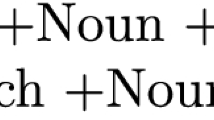Abstract
This paper presents the results of our experience in using an instructional morphological parser (IMP) as a teaching tool in two graduate level courses, one in theoretical morphology and the other in computational morphology. IMP was written in Waterloo PROLOG by the second author and is based on the UDICT morphology system (Byrd 1983). The courses were taught by the first author at the Graduate School of the City University of New York. We present a brief overview of computational morphology and discuss in detail the implementation we used for IMP. We then give an outline of the two courses with some speculation on the computational and linguistic concepts that our students learned. In particular, we discuss the problems we encountered in teaching the notion of recursion.
Similar content being viewed by others
References
Aronoff, Mark. Word Formation in Generative Grammar. Cambridge, MA: MIT Press, 1976.
Bloomfield, Leonard. Language. New York: Holt and Company, 1933.
Bransford, John D. Human Cogniton: Learning, Understanding and Remembering. Belmont, California: Wadsworth, 1979.
Byrd, Roy. J. “Word Formation in Natural Language Processing Systems.” Proceedings of IJCAI-VIII, 1983, pp. 704–706.
Byrd, Roy J., Judith L. Klavans, Mark Aronoff, and Frank Anshen. “Computer Methods for Morphological Analysis.” Proceedings of the Association for Computational Linguistics, 1986, pp. 120–27.
Chomsky, Noam. Aspects of the Theory of Syntax. Cambridge MA: MIT Press, 1965.
Chomsky, Noam. “Remarks on Nominalization.” In Readings in English Transformational Grammar. Ed. Roderick A. Jacobs, and Peter S. Rosenbaum. Waltham, MA: Ginn and Company, 1970, pp. 184–21.
Halle, Morris. “Prologomena to a Theory of Syntax.” Linguistic Inquiry, 4 (1976), 3–16.
Hockett, C. F. A Course in Modern Linguistics. Toronto: Macmillan, 1958.
Koskenniemi, Kimmo, ed. Two-Level Morphology. A General Computational Model for Word-Form Recognition and Production. Publication no. 11. Helsinki, Finland: University of Helsinki, Department of General Linguistics, 1983.
Lees, Robert B. The Grammar of English Complementation. The Hague: Mouton, 1960.
Lovins, Julie Beth. “Development of a Stemming Algorithm.” Journal of Mechanical Translation and Computational Linguistics, 11 (1968), 22–31.
Merriam. Websters Seventh New Collegiate Dictionary. Springfield, MA: G. & C. Merriam, 1963.
Siegal, Dorothy. Topics in English Morphology. PhD Thesis, MIT, 1974.
Tzoukermann, Evelyne, and Roy J. Byrd. “The Application of a Morphological Analyser to On-line Dictionaries.” In Proceedings of the European Conference on Lexicography (EUROLEX). Ed. Tomasz Magay. Budapest, Hungary, 1988.
Winograd, Terry. “An A. I. Approach to English Morphemic Analysis.” A. I. Memo No. 241.MIT A. I. Laboratory. Cambridge, MA, 1971.
Winston, Patrick W. and Berthold K. P. Horn. LISP. Reading, MA: Addison-Wesley, 1981.
Author information
Authors and Affiliations
Additional information
Judith L. Klavans is a research staff member at the IBM T. J. Watson Research Center, where she has worked on various areas in computational lexicography including morphology, semantics, and knowledge representation. She is also an adjunct professor in linguistics at the Graduate School of the City University of New York, where she has taught courses in theoretical and computational linguistics. Recent publications in areas relevant to this paper include “Computational Linguistics” in Contemporary Linguistics: An Introduction, (edited by Mark Aronoff, St. Martin's Press: N. Y., 1989), and “Computer Methods for Morphological Analysis,” with Roy Byrd, Mark Aronoff, and Frank Anshen (in Proceedings of the ACL, 1986).
Martin S. Chodorow is an associate professor of psychology and linguistics at Hunter College and the Graduate School of the City University of New York. He is also a consultant at IBM T. J. Watson Research Center in the Lexical Systems Group. Among his papers on computational lexicography are “Extracting Semantic Hierarchies from a Large On-line Dictionary,” written with Roy Byrd and George Heidorn (in Proceedings of the Association for Computational Linguistics, 1985), and “A Tool for Investigating the Synonomy Relation in a Sense Disambiguated Thesaurus,” written with Yael Ravin and Howard E. Sachar (in Proceedings of the 2nd ACL Conference on Applied NLP, 1988).
Rights and permissions
About this article
Cite this article
Klavans, J.L., Chodorow, M.S. Using a morphological analyzer to teach theoretical morphology. Comput Hum 25, 281–287 (1991). https://doi.org/10.1007/BF00120964
Issue Date:
DOI: https://doi.org/10.1007/BF00120964




